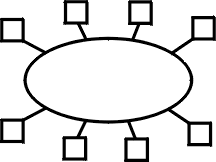|
Thomas Hartman, P.E.
|
AutomatedBuildings.com
|
[an error occurred while processing this directive] |
|
Thomas Hartman, P.E.
|
INTRODUCTION
After languishing for more than a decade in an era of unprecedented advances in technology, the building controls industry is poised for a leap into the world of network based systems. This change will present challenges to all of us who work with building controls, but it will also provide substantial opportunities to those who are willing to take the time to carefully consider the changes taking place and make the adjustments required to accommodate, or even help expedite, this transition by recasting their role in the industry to better support this new era. This essay is intended as reference for those who wish to realign their careers and businesses with this rapidly emerging new era in building controls.
 WHY CHANGES ARE COMING
WHY CHANGES ARE COMING
The most copious example of the advance of networking technologies is the Internet. However, the Internet is much more than an ever present and constantly evolving example of an advanced network. The Internet is rapidly becoming the new model for society's economic, social and political interaction. In short, the Internet displays a unique capacity not just to change our society, but to fundamentally redefine what our society is, just as the automobile did nearly a century ago.
It is not too difficult to see that the "connected" society we are becoming is demanding new paradigms in commercial and residential building operation to meet the needs of the new breed of building occupants and owners. But this connected environment alone would probably not be sufficient to move our industry to the enormous change I see occurring over the next few years. Rather, additional concurrent trends (or undercurrents) are acting as catalysts in a reaction that will propel the building construction industry into an unprecedented era of change and realignment. Among the trends I see as catalytic for this new era of technological growth are:
[an error occurred while processing this directive]It is the confluence of these trends with the significant development of a network based society that I believe is beginning to have an enormous impact on our industry.
LOST OPPORTUNITIES WITH OUTDATED PRACTICES
These trends are fomenting change because many of the processes employed in applying technology based components in the building construction industry are, in a word, outdated. Consider that for most of the last century nearly all commercial building construction projects employed a single contractor for all building controls who represented only one control equipment manufacturer. The job of this controls contractor was to make all HVAC equipment operate according to a sequence of operations spelled out in the project specifications, the development of which was often in total isolation from any knowledge of the equipment applied to carry it out. To complete such a project, controls of the one manufacturer represented by the contractor were applied to every element of the project whether it suited the particular application or not. In addition to digital controls, the controls contractor traditionally supplied actuators, valves, dampers and other equipment to the mechanical contractor(s) and usually supplied some equipment directly to other manufacturers for factory field installation before shipping. As the project neared completion, the controls contractor went through the building, adding many more devices and controllers and connecting all the devices previously supplied to the others. Meanwhile the controls contractors software designers began translating the sequence of operations into digital software (or sometime pneumatic) control programs. That is how most building controls have been implemented for several generations.
Though still common, these practices are embarrassingly out of date. Single sourcing all controls does not make sense in this era of specialization and integration, and it often leads to construction delays and/or cost increases due to coordination problems as product manufacturers try to fit components they may have never seen before on their products in a semi-assembly line environment. The practice also often results in substandard operation because of a lack in planning or consideration about how elements will work together.
On the software side, this process has proven itself not only inefficient, but in many cases it has resulted in poor quality operation of these systems. The designer who developed the control sequences often had little understanding of the controls that would eventually execute the control sequences under development, and the contractor's software designer often failed to understand the intent of the sequence. As a result, sequences have been poorly developed, and then carved up to fit into standard applications programs that are provided by controls manufacturers. As a result, despite the high level of controls capacity provided in many building controls systems today, the HVAC systems in most buildings operate at an extremely elementary level of control.
A TRANSITION TO NETWORK BASED CONTROLS
This outdated approach is resulting in an amount of duplication in controls instrumentation and other control redundancies as much of the equipment being controlled is already shipped with microprocessor units that operate or aid in operation of the unit and provide troubleshooting features. In typical installations, these features are generally absent from the controls networks set up by the controls contractor because of the incompatibility of the digital controls. For example, the extensive digital controls packages supplied by chiller, boiler, and fire alarm manufacturers are largely ignored by the HVAC controls contractors who generally install a few discrete control and/or monitor points to transfer essential information between the systems while ignoring the valuable factory installed instrumentation and logic capabilities and the abundant useful information that could be employed to improve operating features of the system.
COMMUNICATION STANDARDS AND GATEWAYS
 The new paradigm for building control systems is
one in which the field installation is dominated by network connections rather
than installation of discrete monitoring and control points. Multifunctional
equipment such as chillers, boilers, cooling towers, air handlers, VAV boxes,
emergency generators, and even space control and monitoring equipment will come
from factories with integrated control and monitoring devices and logic
capabilities and the primary focus of the controls contractor will be to connect
this equipment into a network that can be operated effectively as a control
system and also meet the objectives for information management of the facility
operator.
The new paradigm for building control systems is
one in which the field installation is dominated by network connections rather
than installation of discrete monitoring and control points. Multifunctional
equipment such as chillers, boilers, cooling towers, air handlers, VAV boxes,
emergency generators, and even space control and monitoring equipment will come
from factories with integrated control and monitoring devices and logic
capabilities and the primary focus of the controls contractor will be to connect
this equipment into a network that can be operated effectively as a control
system and also meet the objectives for information management of the facility
operator.
RESTRUCTURING THE HVAC CONTROLS INDUSTRY
As the trend toward gateways and other interface standards is accelerated by the rising demands and expectations of major industry players, it will soon change forever the way our industry works. The structural changes I recommend be considered as necessary to thrive in this new environment are as follows:
Controls contractors: The most successful control contractors will be those who work to fill a growing void in construction services and increase their sales by recasting themselves as "System Integrators." They must open their sales and support to a number of control system manufacturers and expand their knowledge beyond HVAC systems such that they can offer the most attractive combination of hardware products and networking services that will allow them to capture the growing systems integration market.
Controls manufacturers: Manufacturers of control products will find the construction market for their products shrinking as more and more controls are factory installed under OEM agreements. Manufacturers will also find that the market is no longer looking for a complete "system" from them, but only those components of a system which each can provide most functionally and cost effectively. Successful manufacturers will be those who concentrate their development activities on a limited range of products rather than diffuse their efforts by continuing to try to keep all elements of a their controls system line up to date.
Designers: The design stage will become more important and require designers to develop digital communication expertise that is not widely available in the industry today. A new player in design teams is likely to be a "Network Technology Engineer" who will work with the Owner, Architect and Engineers to develop a total solution that satisfies the operating sequence requirements, and also provides the information management required so that the system provides all the required information management services required, from billing tenants to issuing management reports. The network technology engineer may be a separate entity, or he/she may be part of Owners, Architect's or Engineer's team.
SUMMARY AND CONCLUSION
To capture the value of the emerging capacity to develop control systems that are based on network interconnections rather than installing discrete points requires substantial adjustments to the way products are manufactured and owners, designers and contractors approach their tasks. But such adjustments will be worth the effort. Construction costs and startup problems will be reduced by eliminating the complete design and installation of every system point for every project. More reliable and trouble free operation will be achieved by having complete factory testing of each component with controls in place, and gains from the experience of development activities that include both hardware and controls. Finally, and most importantly, the overall function of the system will be improved by permitting the focus to extend beyond simply implementing a system that operates certain building equipment to including managing the operation in ways that better contribute to the profitability of the project.
Additional information on technologies discussed in this article is available at www.hartmanco.com. Comments and questions about the article may be addressed to Mr. Hartman at tomh@hartmanco.com.
[an error occurred while processing this directive]
[Click Banner To Learn More]
[Home Page] [The Automator] [About] [Subscribe ] [Contact Us]